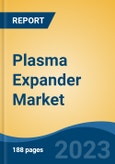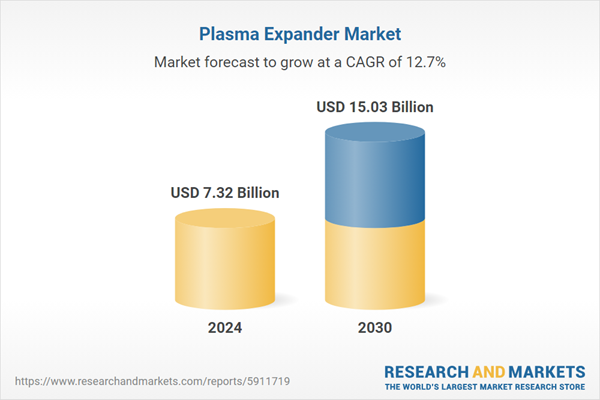Free Webex Call
The Plasma Expander Market was valued at USD 7.32 Billion in 2024, and is expected to reach USD 15.03 Billion by 2030, rising at a CAGR of 12.71%. This market is poised for significant expansion, driven by increasing healthcare demands for volume replacement in critical conditions such as trauma, surgery, burns, and shock. Plasma expanders, vital intravenous solutions, help to restore blood volume and are essential in treating severe dehydration and blood loss. Additionally, the rising prevalence of chronic conditions like heart failure, liver disease, and kidney disorders is further accelerating the demand for these products, as they play a crucial role in managing fluid balance and maintaining cardiovascular health for critically ill patients. The growing frequency of surgeries and intensive medical procedures is also fueling market growth. Speak directly to the analyst to clarify any post sales queries you may have.
10% Free customizationThis report comes with 10% free customization, enabling you to add data that meets your specific business needs.
Several factors are contributing to the rapid progress of the plasma expander market. The increasing adoption of synthetic plasma expanders, such as Hydroxyethyl Starch (HES) and other synthetic colloids, is driving growth due to their effectiveness and cost-efficiency compared to human albumin. Technological advancements in plasma expander manufacturing and formulation are improving their safety and efficacy, enhancing their accessibility and reliability for healthcare providers. The shift toward advanced medical technologies and a heightened focus on critical care management globally is also encouraging investments in plasma expanders, which are crucial in emergency and intensive care settings. Demand for safer and more effective treatment options is prompting innovation in this field, with new formulations addressing challenges related to side effects and safety profiles.
However, the market faces several challenges that may affect its growth. A key concern is the potential side effects of certain synthetic plasma expanders, particularly Hydroxyethyl Starch (HES), which has been linked to kidney damage in some instances. Regulatory challenges related to the approval of new products and complex clinical trials can delay the introduction of new therapies. The high cost of plasma-derived products limits accessibility in low-resource settings, and reliance on human-derived products, such as human albumin, raises concerns about supply shortages, ethical considerations, and the risk of pathogen transmission. To address these challenges, the market must focus on developing safer and more effective alternatives while improving accessibility to meet the growing demand for plasma expander treatments globally.
Key Market Drivers
Technological Advancements:
Researchers are actively working on developing new formulations of plasma expanders to improve volume-expanding properties while reducing side effects like coagulation disturbances and kidney injury. Advances are also being made in the creation of synthetic plasma expanders that do not rely on human or animal plasma, reducing the risk of infections and immunological reactions.The development of biodegradable plasma expanders, which break down naturally in the body over time, is also underway. Additionally, nanotechnology is being used to enhance the properties of plasma expanders by improving drug delivery, circulation time, and tissue targeting. Technological innovations have led to improved safety profiles, longer shelf life, and more accurate real-time monitoring of patient responses to plasma expanders. In India, for example, the Department of Science and Technology (DST) and the Central Institute of Petrochemicals Engineering & Technology (CIPET) have been pivotal in promoting research and development in this area, further contributing to the advancement of plasma expanders.
Key Market Challenges
Cost Containment:
Healthcare systems globally face budget constraints, leading to cost-containment measures that may impact the purchasing of plasma expanders. The plasma expander market is highly competitive, with multiple manufacturers offering a range of products, which may result in price pressure and reduced profit margins. Additionally, reimbursement policies from government and private insurers can impact the financial viability of plasma expander products, and economic downturns can shift preferences toward cost-effective alternatives. The high costs associated with research, development, and regulatory compliance also complicate the market dynamics, requiring manufacturers to balance affordability with profitability. Efficient supply chain management is essential for reducing costs related to production, distribution, and storage.Key Market Trends
Shift Toward Plasma Expanders Over Blood Transfusions:
The preference for plasma expanders over blood transfusions is a major driver for market growth. While blood transfusions have traditionally been used to treat significant blood loss, they carry risks such as immunological reactions, infections, blood type mismatches, and allergic responses. Plasma expanders, by mimicking human plasma, offer a safer alternative as they do not carry the same risks of transfusion reactions and infections. They are easier to store, have a longer shelf life, and are more cost-effective than blood transfusions, which involve high costs for blood collection, screening, and storage. As healthcare systems focus on improving trauma care efficiency, plasma expanders are increasingly becoming the preferred method for volume restoration in critical patients, particularly in emergency settings and remote areas with limited access to blood banks.Key Market Players
- Baxter International Inc.
- Fresenius SE & Co. KGaA
- CSL Limited
- Grifols, S.A.
- B. Braun Melsungen AG
- Hikma Pharmaceuticals PLC
- Octapharma AG
- Kedrion S.p.A.
- Shanghai RAAS Blood Products Co., Ltd.
- Terumo Corporation
Report Scope:
This report segments the Global Plasma Expander Market by product type, end-user, and region, highlighting industry trends and market dynamics.Product Type Segmentation:
- Dextran
- Hydroxyethyl Starch
- Human Albumin
- PEGylated Albumin
- Polyvinylpyrrolidone (PVP)
- Gelatin
End-User Segmentation:
- Online Pharmacies
- Retail Pharmacies
- Hospital Pharmacies
Regional Segmentation:
- North America
- Asia-Pacific
- Europe
- South America
- Middle East & Africa
Competitive Landscape:
Detailed profiles of key market players are included in the report.Available Customizations:
TechSci Research offers customization options for the Global Plasma Expander Market report, including additional market player analysis and other specific insights tailored to company needs.Additional company analysis and profiling (up to five additional market players).
This product will be delivered within 1-3 business days.
Table of Contents
1. Product Overview
2. Research Methodology
3. Executive Summary
5. Global Plasma Expander Market Outlook
6. Asia Pacific Plasma Expander Market Outlook
7. Europe Plasma Expander Market Outlook
8. North America Plasma Expander Market Outlook
9. South America Plasma Expander Market Outlook
10. Middle East and Africa Plasma Expander Market Outlook
11. Market Dynamics
12. Market Trends & Developments
14. Porter’s Five Forces Analysis
16. Competitive Landscape
Companies Mentioned
- Baxter International Inc.
- Fresenius SE & Co. KGaA
- CSL Limited
- Grifols, S.A.
- B. Braun Melsungen AG
- Hikma Pharmaceuticals PLC
- Octapharma AG
- Kedrion S.p.A.
- Shanghai RAAS Blood Products Co., Ltd.
- Terumo Corporation
Table Information
| Report Attribute | Details |
|---|---|
| No. of Pages | 186 |
| Published | February 2025 |
| Forecast Period | 2024 - 2030 |
| Estimated Market Value ( USD | $ 7.32 Billion |
| Forecasted Market Value ( USD | $ 15.03 Billion |
| Compound Annual Growth Rate | 12.7% |
| Regions Covered | Global |
| No. of Companies Mentioned | 10 |









